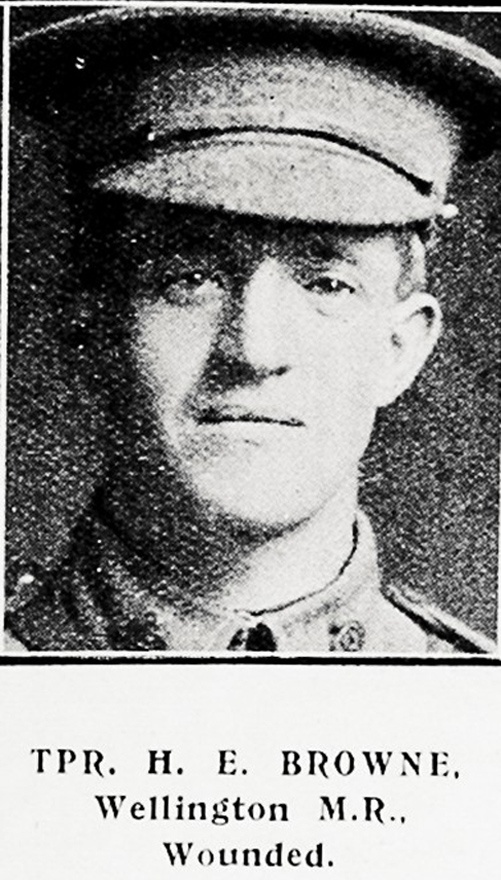
Harry Browne was born in Whakatane on 11 April 1887. He was one of 12 children born to William and Ellen Browne, who both worked with the Native Schools Department.
Browne was working as a baker in Wellington when the First World War began. An ex-school cadet, he enlisted in the NZEF on 28 August 1914.
Joining the 6th (Manawatu) Squadron, Wellington Mounted Rifles Regiment, Browne arrived at Gallipoli on 12 May 1915. He missed the main landings on 25 April because the New Zealand Mounted Rifles Brigade had remained behind in Egypt as reinforcements. They landed on the peninsula without their horses, which were unsuitable for the rugged Gallipoli terrain.
After arriving at Anzac Cove, the Wellington Mounted Rifles relieved Royal Naval Brigade units on the right of Walker’s Ridge. The Mounteds experienced their baptism of fire on 18-19 May when the Ottomans launched a massed attack against Quinn’s Post and the Nek. They were able to hold their line and inflicted massive casualties on the advancing enemy soldiers.
The Wellington Mounted Rifles remained on Walkers Ridge until the August offensive. On 5 August, they moved north to No. 1 Outpost. Their task was to support the assault on Chunuk Bair.
Lieutenant Colonel William Malone’s Wellington Infantry Battalion captured the slopes of Chunuk Bair in the early hours of 8 August. They held the position throughout the day, but suffered severe casualties.
Around midday on 8 August, the 2nd and 6th squadrons of the Wellington Mounted Rifles moved up from Table Top to reinforce Malone’s men on Chunuk Bair. It took them several hours to reach Chunuk Bair because of the difficult terrain and heavy fighting. They finally arrived at 10.30 p.m. and occupied the central position in the hastily dug trenches around the summit.
Under the command of Lieutenant-Colonel William Meldrum, the Wellington Mounted Rifles held their tenuous position, despite suffering over 60% casualties. This included Browne, who suffered a leg wound on 9 August. He described the heavy fighting on the summit of Chunuk Bair in an account written after the offensive:
Towards dawn the Turks came on vigorously their cries of ‘Allah, Allah’, mingling strangely with the hoarse cries of our fellows. Then things were brought to a climax, when shells from our destroyers commenced falling among us causing terrible havoc ...Thus with the fire of the enemy on three sides, and our own guns blowing us to glory from behind, the place became a corner of Hell … a man was blown thirty feet into the air by a naval shell, his limbs out spread, his whole body in silhouette against the sky. Yet another shell and the charred trunk of another man’s body fell near us. Simultaneously the enemy attacked fiercely his hand grenades taking deadly effect … the brunt of the attack was falling on the 6th. Captain Hastings who was holding one troop in reserve sent them on a counter charge … [A]s they reached the front parapet they encountered such a hail of fire and bombs that the unfortunate survivors broke, and as they were running back, carried the chaps in our trench with them … It was now that the remainder in the front trench were wiped out … One moment they were working their rifles like men possessed, and shouting defiance, and the next they lay crumpled up in the trench. Two only survived … and they joined Sandy and I in as hot a defence as ever four men were ever called upon to put up … where once a squadron had been. Bombs were coming over fast and when they burst in our little parapet would obscure us from one another ... We were now firing for all we were worth, necessity seeming to add deadliness to our aim although one did not need to be a crack shot at such close range. Nevertheless I found myself driving chiefly for the head … with a strange feeling of assurance that the bullet would find its mark … The fierce joy of battle, not always experienced, was in the air. Many grenades went over killing the wounded on the slope[s]. At last, another, landing in our trench … about six feet [away,] … caught me in the knees. I scrambled out thinking my right knee-cap had gone … I paused and looked down to find but a small hole just below the knee-cap and a little blood trickling down … A stop to put a proper dressing on might have meant disaster just then. ‘Are we downhearted’ cried someone. ‘No!’ was the hoarsed crack chorus of voices. This with cheering now and again, we did give Abdul a false impression of our strength. Another rally by the Turks was beaten back and the enemy accepted for the time being his defeat, settling down to vigorous sniping from both flanks. Presently one of our Sergeants and a few men returned swelling our numbers to eight or ten … We were standing on our own mates but they wouldn’t mind and we were too exhausted to lift them out. Such was the scene upon Chunuk Bair, upon which the sun shone on the morning of Monday 9th August … for the New Zealanders had not died there for nothing.
Invalided to England for treatment, Browne did not return to Gallipoli. When in hospital, Browne he wrote a detailed account of his role in the August Offensive.
After recovering from the wounds he received at Chunuk Bair, Browne transferred to the New Zealand Field Artillery in May 1916 and served on the Western Front. He took part in the battles of the Somme and Messines before a serious chest wound ended his war in June 1917. He never fully recovered from his injury, and died from pneumonia in 1928. His grave lies in Karori Cemetery in Wellington.


Community contributions